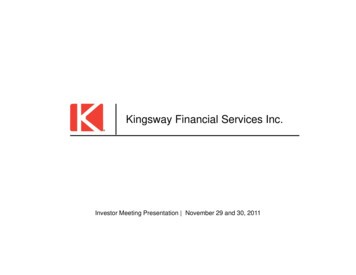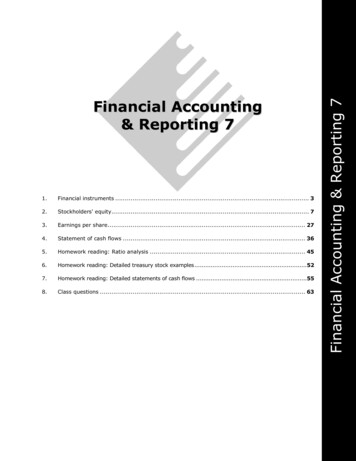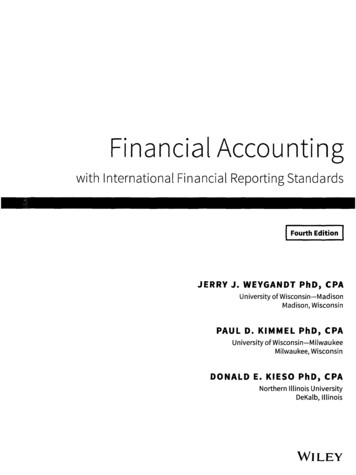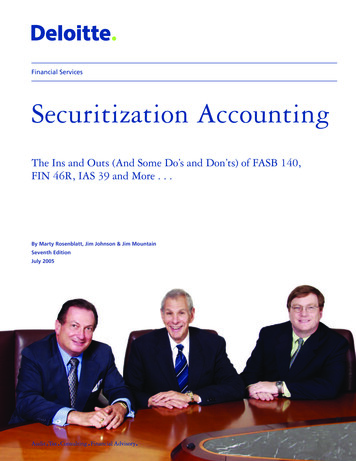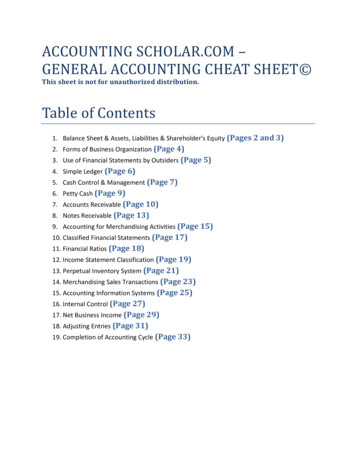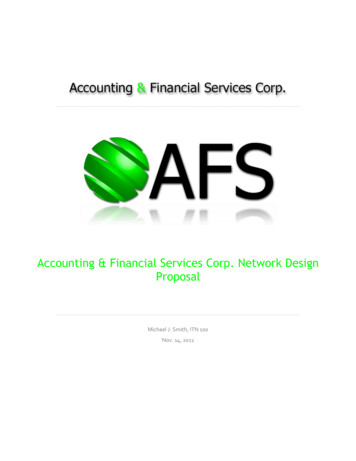
Transcription
Accounting & Financial Services Corp. Network DesignProposalMichael J. Smith, ITN 100Nov. 14, 2011
Accounting & Financial Services Corp. Network DesignProposal 2IntroductionCONTENTSIntroduction2Executive Summary4Project DescriptionNetwork ObjectivesDesign AssumptionsNetwork Needs4555Geographic Scope5Application Systems5Network Users6Transmission Speed Requirements6Security Requirements6AFS Network Design6AFS WAN High-Level Design6AFS WAN Architecture7Network Technology7Cabling7Security8Hardware Configuration8AFS BN High-Level Design10AFS BN Architecture10Network Technology10Cabling10Security10Hardware Configuration10
Accounting & Financial Services Corp. Network DesignProposal 3AFS LAN High-Level Design12AFS LAN Architecture12Network Technology13Cabling13Security13Hardware Configuration13IP Addressing20OSI Model22Cost23
Accounting & Financial Services Corp. Network DesignProposal 4Executive SummaryAccounting & Financial Service Corporation (AFS) is a financial accounting firm with 1,600 employees spread across sevenlocations in the United States. The company seeks a new network that will link all offices with the headquarters for securefile sharing and application sharing.AFS’s network design will consist of a wide-area-network (WAN) with 1000Base-FX Gigabit Ethernet over fiber optic cableusing a star architecture. The WAN will be connected to a rack-mounted switched backbone network (BN) that uses100Base-TX Ethernet over Category 5 cables. The BNs will contain layer 2 and layer 3 switches. The BNs will be connectedto switched 100Base-TX Ethernet local-area-networks that use multipoint circuits in a star topology.Each local-area-network (LAN) will connect several department workstations to database, file and print services, as well asthe AFS BN, which will in turn connect workstations to the WAN.Project DescriptionNETWORK OBJECTIVESThe proposed network isdesigned to link AFSHeadquarters, located in Fairfax,VA, to the company’s six branchoffices, located in Burbank, CA,Denver, CO, Dublin, OH,Greensboro, NC, Omaha, NE,and Seattle, WA.AFS HQ contains sevendepartments that will be linkedby the network. Each branchoffice consists of fivedepartments that will also belinked by the network. SECURITYDenverThe network must be designed to preventunauthorized access, both logically andphysically.BurbankDublinThe network must provide enoughbandwidth to meet demand during periodsof peak usage.FairfaxSeattleGreensboroOmaha SCALABILITYBRANCH LOCATIONSGREENSBORO, NC RELIABILITYThe network must contain redundancy toensure that the failure of one system will notbring the entire network down.The table below details the distance between each branch office and theheadquarters. This will be used to determine the amount of cable needed.DUBLIN, OH SPEEDDistance to HQ in milesDistance to HQ in feet5002.64 Million3001.58 MillionDENVER, CO1,8009.5 MillionBURBANK, CA2,70014.26 MillionSEATTLE, WA2,80014.78 MillionOMAHA, NE1,2006.33 MillionThe network must be capable of sustainingscalability without the need to rebuild theentire network. Changes and updates mustbe easy to implement.
Accounting & Financial Services Corp. Network DesignProposal 5Network ObjectivesThe network is designed to meet the following requirements: Security. The network must be designed to prevent unauthorized access, both logically and physically.Speed. The network must provide enough bandwidth to meet demand during periods of peak usage.Reliability. The network must contain redundancy to ensure that the failure of one system will not bring theentire network down.Scalability. The network must be capable of sustaining scalability without the need to rebuild the entire network.Changes and updates must be easy to implement.Design AssumptionsThis network design makes the following assumptions: AFS does not currently have a network. The entire infrastructure will be built from scratch.AFS wants to build all circuits in the network instead of leasing them.Each department resides on a separate floor within AFS offices.AFS does not share buildings with any other businesses.AFS wants to use Microsoft operating systems and productivity suites. They also want to use Adobe graphic designproducts.AFS throughput rates indicate that 100Base-TX for LANs and 1000Base-FX for the WAN will suffice.AFS will maintain physical security of the network. The network design must only ensure that it is logically secure.Network NeedsThe majority of traffic on this network will be file sharing including reports, brochures, accounting information, financialinformation, and personnel profiles. The network will also need to handle graphics-heavy files, web pages, and severaldatabases. At this time, AFS is not interested in VoIP or video teleconferencing.The network will need to accommodate AFS’s 1,600 employees across seven locations.Geographic ScopeThe AFS network will consist of the following layers: Access Layer: Dell OmniPlex 390 desktop or Dell Latitude E6420 laptop.Distribution Layer: Cisco 3560x-48T-L switch.Core Layer: Cisco 3750x-48P-S switchThe AFS wide-area-network (core layer) will experience most of the traffic in this network design, thus faster connectionswill be used in this layer. The distribution and access layers will need to meet network requirements, but they do notrequire the same speed as the WAN. Connections for these layers will not be as fast as those for the WAN to keep costsdown.Application SystemsAFS will have two choices of software configurations within this design. The company wants to use Microsoft operatingsystems and productivity suites. They also want to use Adobe graphic design products.
Accounting & Financial Services Corp. Network DesignProposal 6The first configuration includes MS Windows 7, MS Windows Server 2008, MS Office Pro, Adobe Acrobat, Sage PeachtreeQuantum Platinum, Staff Files Pro, HR Document Maker, Adobe Creative Suite Master Collection, ManageEngineSupportCenter Plus, ManageEngine ServiceDesk Plus, SolarWinds Orion PM, and OmniPage Enterprise.The second configuration includes MS Windows 7, MS Windows Server 2008, MS Office Pro, Adobe Acrobat, QuickBooksEnterprise Solution, HRA HRIS, Adobe Creative Suite Master Collection, SysAid, LBE Help Desk, AdRem NetCrunch 6, andEndNote X3.Most of the applications in both configurations will use HTTP over TCP/IP and Windows file access. Adobe Creative Suitewill also use FTP. Sage Peachtree Quantum will use Remote Desktop Protocol (RDP).Network UsersThe network needs to accommodate 1,600 users. Each department will generate different levels of traffic. The highestamount of traffic will come from the accounting and finance departments in the form of document sharing and accessingdatabases. Customer service will generate the least amount of traffic.Transmission Speed RequirementsAccess to network resources should be as seamless as possible, meaning that the network needs to handle transmission asquickly possible. Based on analysis of AFS’s usage, data rates of 100 Mbps for LANs and 1 Gbps for the WAN will meetnetwork demand.Security RequirementsAFS wants a physically and logically secure network. To keep costs down, AFS has decided to keep computers and serversbehind locked doors with controlled access. Access to buildings will also be controlled, with security guards, access cards,and a surveillance system.This design will only include services to keep the network logically secure. AFS will administer physical security.User names and passwords will be used to limit access as well. Permissions will be assigned by department to keep internalthreats to a minimum. Employees will only have access to files and servers they need to perform their job functions.Should an employee need access to information beyond the scope of their job, management approval will be required.AFS Network DesignAFS’s network design consists of one wide-area-network connecting all the offices to AFS headquarters. The WAN isconnected to AFS’s backbone network, which will connect all the LANs in each branch office to the WAN. Each employee’sworkstation will be connected to a department LAN, which will allow departments to share files and database information.AFS WAN High-Level DesignAFS’s WAN employs a star architecture, which will be easier to manage than a ring architecture. The star architecture willalso be faster because information will not need to make its way around the ring to get to HQ. The AFS WAN will not bemeshed to save money. The high-level design appears below.
Accounting & Financial Services Corp. Network DesignProposal 7Figure 1. High-Level DesignAFS WAN ArchitectureNetwork TechnologyFrame Relay and Asynchronous Transfer Mode (ATM) were considered for use in AFS’s WAN, but ultimately 1000Base-FXGigabit Ethernet over fiber optic cable was chosen. Both Frame Relay and ATM were at a disadvantage from the startbecause they create latency due to protocol conversion.With the selection of Gigabit Ethernet, the entire network topology would use the same technology, which eliminates theneed for additional protocols and complexities. Gigabit Ethernet will also allow AFS to make incremental investments inexpansion, should AFS decide to open another branch office in the future.CablingThe AFS WAN will contain connections between each branch office and the headquarters. Fiber optic cable will be laidbetween each office. Cabling distances were determined using the distances between cities. While this design assumes theAFS wants to lay their own cable, it is highly recommended that they use leased lines.The table below lists the amount of 1000-ft. cable rolls needed based on distance to headquarters based on the table in theproject description.
Accounting & Financial Services Corp. Network DesignProposal 8Table 1. Cabling NeedsLOCATION1000 FT. ROLLSDUBLIN, OH2,641GREENSBORO, NC1,584DENVER, CO9,504BURBANK, CA14,256SEATTLE, WA14,784OMAHA, NE6,336TOTAL49,104A total of 49,104 rolls of 1,000-ft fiber optic cable would need to be run between the offices and the HQ.If AFS chooses to buy their fiber optic cable from FiberCables, it will cost 8.4 million. If they choose to buy fromUltraSpec, the cost will be 9.8 million. This does not include the cost of shipping, nor does it include construction costs tophysically lay the cable.SecurityAll traffic to the Internet will be routed through AFS HQ to limit the points at which an outside attack can occur. TheDublin, OH office has redundancy built in, should the connection at HQ experience problems. If the network experiencesbottlenecks, additional entry points can be added to other offices, but this increases points of entry for attackers.AFS HQ and the Dublin office each have firewalls to protect the network. They are the only offices on the AFS network tohave firewalls, as they are the only locations that have connections to the outside Internet. Additionally, they have trafficanomaly detection systems to help identify attacks, generate alarms, and terminate connections with hostile sources.They also contain intrusion prevention systems that identify malicious activity, log information about the activity, attemptto block the activity and report it.AFS also has demilitarized zones (DMZ) at each location that contain email servers, should an intruder get past the IDS,the IPS, and firewall. The DMZ at AFS HQ also contains the company’s web server.Hardware ConfigurationThe AFS WAN uses 1 GbE over fiber cables. Because AFS department LANs use 100 Mbps Ethernet over Cat 5e cable,media converters must be used. AFS can choose Omnitron’s iConverter GX/TM converter or Transition Networks StandAlone Converter SGETF1024-110. The network requires seven converters but AFS should purchase at least eight, shouldone experience problems. Purchasing from Omnitron would cost 12,115, while purchasing from Transition would cost 13,325.The core layer of each office will be equipped with a layer 3 (L3) switch. By using L3 switches, AFS can configure vLANs inthe future if, for example, they wanted all of the HR departments to share the same circuit. They can choose Cisco’s 3750XCatalyst 48P-S or Netgear’s Prosafe L3 switch. Each location needs one switch, thus eight are recommended, includingone to be used if another experiences problems. The total cost for the Cisco switches will be 40,600, while the Netgearswitches will cost 24,000.
Accounting & Financial Services Corp. Network DesignProposal 9The distribution layer of each office will contain six layer 2 (L2) switches (one for each LAN, one for the DMZ). Because AFSHQ has seven departments, that location will require eight switches. More details about those switches can be found inHardware Configuration under the AFS BN section.Diagram shows the AFS WAN configuration. The figure does not contain all branch office information, due to spaceconstraints. The AFS LAN and BN sections contain diagrams of the specific locations. The LANs here are for illustrationpurpose only. Similarly, the figure does not contain all HQ information. That can be found in the AFS Hardware subsectionof the AFA LAN Architecture section.Figure 2. AFS Wide Area NetworkImportant Points: Each location has a router.Each location is connected to AFS HQ using 1GbE over fiber cables. (1000Base-FX).Each location has a media converter.All Internet traffic is routed to AFS HQ to limit entry points.The Dublin office contains redundancy, should the connection to AFS HQ experience problems.Both AFS HQ and Dublin have firewalls and anomaly detection systems.
Accounting & Financial Services Corp. Network DesignProposal 10 Each location has a L3 switch.AFS BN High-Level DesignAFS’s backbone network will use switched backbones with a star topology. All backbone switches are located in a secureroom in the basement of each office. This design has been employed to allow easy maintenance and upgrading. While thismeans more cable is needed, AFS has identified scalability as an important design feature.AFS BN ArchitectureNetwork TechnologyFor AFS BNs, 100Base-TX Ethernet will be used to keep costs down. In the future, AFS can replace Ethernet with GbE, butat this time, 100 Mbps should suffice.Switching to GbE in the BNs would not have eliminated the need for media converters in the WAN, thus the additional costto outfit the BN with GbE was not necessary. Thus AFS decided to pass on that option.CablingThe GbE connection from the AFS WAN runs through the media converter to the L3 switch. Once there, the L3 switch willbe connected to six L2 switches at each branch office (five department switches, one DMZ switch). In the AFS HQ BN, theL3 switch will be connected to eight L2 switches.Because those switches will all be located in the same room, not much Cat 5e is required. Less than 10 ft. per connectionshould suffice. Cat 5e price information can be found under the Cabling subsection of AFS LAN Architecture.SecurityBecause the WAN will only have one entry point, the BNs will not have firewalls. Security will be handled by the WAN. Formore information about security, see the Security subsection under AFS WAN Architecture.Hardware ConfigurationThe AFS BN s require 44 L2 switches. Six for each branch office (36 total) and eight for HQ. It is recommended that AFSpurchase one additional switch for each location, bringing the total to 51. If AFS chooses the Cisco 3560X-48T-L, the totalcost will be 171,360. If they choose the Netgear Prosafe L2 switch, the total cost will be 168,300.The switches will be rack-mounted in the basement of the each building. Each location will need two racks, with theexception of the HQ, which will need four. If AFS chooses the StarTech Rack, the total cost will be about 3,700. Thesecond option is an Innovation First rack. If AFS chooses Innovation, the total cost would be 3,100.The diagram shows the AFS HQ BN.
Accounting & Financial Services Corp. Network DesignProposal 11Figure 3. AFS Headquarters Backbone NetworkImportant Points: AFS headquarters has seven departments; therefore it needs eight L2 switches. One for each LAN and one for theDMZ.AFS HQ needs one L3 switch to connect the core layer to the distribution layer.100Base-TX over Cat 5e will be used in the AFS HQ BN.The HQ BN will not contain any security beyond the DMZ, as security will be handled by the anomaly detector andfirewall at HQ.This diagram shows the BN of a branch office. All branch office locations will be configured in this way for simplicity.Because this diagram represents all branch offices, IP addresses were left off, as they would depend on the departmentand location.
Accounting & Financial Services Corp. Network DesignProposal 12Figure 4. AFS Branch Office Backbone NetworkImportant Points: Each branch office has five departments; therefore it needs six L2 switches: one for each LAN, one for the DMZ.Each branch office needs one L3 switch to connect the distribution layer to the core layer.100Base-TX over Cat 5e will be used in the AFS branch office BN.The branch office BNs will not contain any security beyond the DMZ, as security will be handled by the anomalydetector and firewall at HQ.AFS LAN High-Level DesignAFS department LANs will be dedicated-server networks, allowing users to share files and printers. LANs of this size wouldbe severely limited if a peer-to-peer network was used. Multipoint circuits will be used in LANs to minimize costs. LANs willhave a star topology.AFS LAN Architecture
Accounting & Financial Services Corp. Network DesignProposal 13Network TechnologyFor all of the local area networks in AFS’s network, switched 100Base-TX Ethernet was chosen because it provides betterperformance than shared Ethernet using hubs, and is cheaper than fitting an entire office building with fiber optic cables,the main reason 100Base-TX not 1000Base-FX was chosen for AFS LANs.Switched 100Base-TX was also chosen because each circuit connected to a switch acts as a separate point-to-pointconnection, which lowers the probability of collisions. On LANs of these size, having a hub retransmit every message to allhosts would severely slow the network, thus switched Ethernet is a better option. It has been said that Ethernet can use upto 95% of its capacity before problems arise, which translates into speeds of roughly 95 Mbps. That should be enough tomeet AFS’s needs.CablingOperating under the assumption that AFS does not share its building with other tenants and each department is locatedon a different floor, at the branch offices, no employee will be more than 50 ft. vertically from the main distribution facility.Each building has five floors, with eight-foot ceilings and about two feet of structural space between floors for a total of 50ft. At AFS HQ, using the same assumptions, no employee will be more than 70 ft. from the MDF.Roughly 70 feet of cable per employee would most likely cover each employee (only the furthest employees will be 70 ft.from the MDF), but to be safe, 75 ft. per employee will be used, to account for Cat 5e cable needed for the BN connections.AFS HQ would require 30 rolls of 1,000-ft cable; each branch office would need 15 rolls for a total of 120 rolls.If AFS buys their Category 5e cable from Sewell, the total will be about 7,800. If they instead choose Black Box, the cablewill be 4,800.SecurityBecause the WAN will only have one entry point, the LANs will not have firewalls. Security will be handled by the firewalland anomaly detector at AFS HQ. For more information about security, see the Security subsection under AFS WANArchitecture.Hardware ConfigurationAFS HQAt AFS HQ, the MDF will house all of the servers for AFS’s networks, except department file, database, and print servers.AFS HQ will require two domain controllers to handle its 400 employees. It will have one database server, which willcontain information specific to all of AFS, not individual departments. AFS will also assign IP addresse
SupportCenter Plus, ManageEngine ServiceDesk Plus, SolarWinds Orion PM, and OmniPage Enterprise. The second configuration includes MS Windows 7, MS Windows Server 2008, MS Office Pro, Adobe Acrobat, QuickBooks Enterprise Solution, HRA HRIS, Adobe Creative Suite Master



